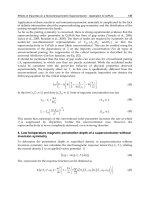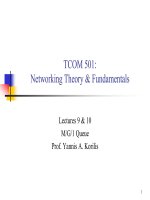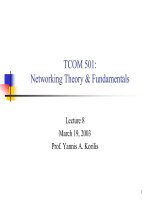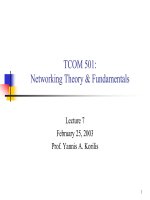Networking Theory and Fundamentals - Lecture 7 doc
Bạn đang xem bản rút gọn của tài liệu. Xem và tải ngay bản đầy đủ của tài liệu tại đây (235.58 KB, 15 trang )
1
TCOM 501:
Networking Theory & Fundamentals
Lecture 7
February 25, 2003
Prof. Yannis A. Korilis
7-2
Topics
Open Jackson Networks
Network Flows
State-Dependent Service Rates
Networks of Transmission Lines
Kleinrock’s Assumption
8-3
Networks of ./M/1 Queues
Network of K nodes; Node i is ./M/1-FCFS queue with service rate µ
i
External arrivals independent Poisson processes
γ
i
: rate of external arrivals at node i
Markovian routing: customer completing service at node i
is routed to node j with probability r
ij
or
exits the network with probability r
i0
=1-∑
j
r
ij
Routing matrix R=[r
ij
] irreducible ⇒ external arrivals eventually exit
the system
i
j
k
0i
r
ik
r
ij
r
i
γ
1
γ
8-4
Networks of ./M/1 Queues
Definition: A Jackson network is the continuous time Markov chain
{N(t)}, with N(t)=(N
1
(t),…, N
K
(t)) that describes the evolution of the
previously defined network
Possible states: n=(n
1
, n
2
,…, n
K
), n
i
=1,2,…, i=1,2, ,K
For any state n define the following operators:
Transition rates for the Jackson network:
while q(n,m)=0 for all other states m
arrival at
departure from
transition from to
ii
ii
ij i j
An n e i
Dn n e i
Tn n e e i j
=
+
=−
=−+
0
(, )
( , ) { 0} , 1, ,
(, ) { 0}
ii
iiii
ij i ij i
qnAn
qnDn r n i j K
qnTn r n
=
γ
=µ ⋅ > =
=µ ⋅ >
1
1
8-5
Jackson’s Theorem for Open Networks
λ
i
: total arrival rate at node i
Open network: for some node j: γ
j
>0
Linear system has a unique solution λ
1
, λ
2
,…, λ
K
Theorem 13: Consider a Jackson network, where ρ
i
=λ/µ
i
<1, for every
node i. The stationary distribution of the network is
where for every node i =1,2,…,K
1
1
() ( ), , , 0
K
ii K
i
pn p n n n
=
=
≥
∏
…
() (1 ) , 0
i
n
ii i i i
pn n
=
−≥
ρρ
i
j
k
0i
r
ik
r
ij
r
i
γ
1
γ
1
,1, ,
K
ii jji
j
ri K
=
λ=γ+ λ =
∑
8-6
Jackson’s Theorem (proof)
Guess the reverse Markov chain and use Theorem 4
Claim: The network reversed in time is a Jackson network with the
same service rates, while the arrival rates and routing probabilities are
Verify that for any states n and m≠n,
Need to prove only for m=A
i
n, D
i
n, T
ij
n. We show the proof for the first
two cases – the third is similar
** *
00
,,
jji
i
iii ij i
ii
r
rr r
λ
γ
γ=λ = =
λ
λ
*
() (,) ()(,)
p
mq mn pnqnm
=
** *
0
(,) (, ) (/)
iiiiiiiii
qAnn qAnDAn r==µ=µγλ
*
()(,) ()(,) ()(/) () () ()
ii i iiii i ii
p
Anq Ann pnqnAn pAn pn pAn pn
=
⇔µγλ=γ⇔ =ρ
** *
0
(,) (, )
iiiiiii
qDnn qDnADn r==γ=λ
*
00
()(,) ()(,) () ()1
{
0
}
i i i i ii ii i
pDnq Dnn pnqnDn pDn r pn r n
=
⇔λ=µ>
() ()1{ 0}
ii i
pDn pn n
⇔
ρ= >
8-7
Jackson’s Theorem (proof cont.)
Finally, verify that for any state n:
Thus, we need to show that ∑
i
γ
i
=∑
i
λ
i
r
i0
*
(, ) (, )
mn mn
qnm q nm
≠≠
=
∑
∑
0
()
iiiiijiiij
iiijiji
ijj j
ij j
rrrλ = λ− λ = λ− λ
=λ−λ−γ=γ
∑∑∑∑∑∑∑
∑∑ ∑
0
0
,
(,) 1{0} 1{0}
[]1{0}
1{ 0}
ij
ij i
iii iii
mn i ij i
ii i
iij
iii
ii
qnm r n r n
rr n
n
≠
=γ+µ >+µ >
=γ+µ + ⋅ >
=γ+µ >
∑∑∑ ∑
∑∑∑
∑∑
**
0
(,) 1{0} 1{0}
iii ii ii
mn i i i i
qnm n r n
≠
=γ+µ >=λ+µ >
∑∑∑ ∑∑
8-8
Output Theorem for Jackson Networks
Theorem 14: The reversed chain of a stationary open Jackson network is
also a stationary open Jackson network with the same service rates,
while the arrival rates and routing probabilities are
Theorem 15: In a stationary open Jackson network the departure process
from the system at node i is Poisson with rate λ
i
r
i0
. The departure
processes are independent of each other, and at any time t, their past up
to t is independent of the state of the system N(t).
Remark: The total arrival process at a given node is not Poisson. The
departure process from the node is not Poisson either. However, the
process of the customers that exit the network at the node is Poisson.
** *
00
,,
jji
i
iii ij i
ii
r
rr r
λ
γ
γ=λ = =
λ
λ
8-9
Arrival Theorem in Open Jackson Networks
The composite arrival process at node i in an open Jackson network
has the “PASTA” property, although it need not be a Poisson process
Theorem 16: In an open Jackson network at steady-state, the
probability that a composite arrival at node i finds n customers at that
node is equal to the (unconditional) probability of n customers at that
node:
Proof is omitted
( ) (1 ) , 0, 1, ,
n
iii
p
nniK
=
−≥=
ρ
ρ
i
j
k
i
λ
8-10
Non-Poisson Internal Flows
Jackson’s theorem: the numbers of customers in the queues are
distributed as if each queue i is an isolated M/M/1 with arrival rate
λ
i
, independent of all others
Total arrival process at a queue, however, need not be Poisson
“Loops” allow a customer to visit the same queue multiple times
and introduce dependencies that violate the Poisson property
Internal flows are Poisson in acyclic networks
Similarly. the departure process from a queue is not Poisson in
general
The process of departures that exit the network at the node is
Poisson according to the output theorem
8-11
Non-Poisson Internal Flows
Queue
>>
µ
λ
′
λ
p
1 p
−
′
λ
λ
λ
Poisson
Poisson
Example: Single queue with µ >> λ, where upon service completion a
customer is fed back with probability p ≈1, joining the end of the queue
The total arrival process does not have independent interarrival times:
If an arrival occurs at time t, there is a very high probability that a feedback
arrival will follow in (t, t+δ]
At arbitrary t, the probability of an arrival in (t, t+δ] is small since λ is small
Arrival process consists of bursts, each burst triggered by a single
customer arrival
Exact analysis: the above probabilities are respectively
0
(), (1 ) ()po p poλδ +µδ + δ λδ + − ⋅µδ + δ
8-12
Non-Poisson Internal Flows (cont.)
λ
Poisson
µ
′
λ
λ
p
1
p
−
Poisson
′
λ
Example: Single queue, exponential service times with rate µ, Poisson
arrivals with rate λ. Upon service completion a customer is fed back at the
end of the queue with probability p or leaves with probability 1-p
Composite arrival rate and steady-state distribution:
Probability of a composite arrival in (t, t+δ]:
Probability of a composite arrival in (t, t+δ], given that a composite arrival
occurred in (t-δ, t]:
() ()po o
′
λ
δ+µδ+δ>λδ+δ
11
/(1 )rp p
′′ ′′
λ =λ+λ =λ+λ ⇒λ =λ −
() (1 ) , 0; / /(1 )
n
pn n p
′
=−ρρ ≥ ρ=λµ=λ −µ
0
(1 ) ( ) ( ) ( )
(1 )
ppo po o
p
λ
′
λδ+ − ⋅µδ⋅ + δ =λδ+ δ+ δ =λδ+ δ
−µ
8-13
State-Dependent Service Rates
Service rate at node i depends on the number of customers at that node:
µ
i
(n
i
) when there are n
i
customers at node i
./M/c and ./M/∞ queues
Theorem 17: The stationary distribution of an open Jackson network
where the nodes have state-dependent service rates is
where for every node i =1,2,…,K
with normalization constant
Proof follows identical steps with the proof of Theorem 13
1
1
() ( ), , , 0
K
ii K
i
pn p n n n
=
=
≥
∏
…
1
() , 0
(1) ( )
i
n
i
ii i
ii ii
pn n
Gn
λ
=
≥
µµ
0
(1) ( )
i
i
n
i
i
n
iii
G
n
∞
=
λ
=
<∞
µµ
∑
8-14
Network of Transmission Lines
Real Networks: Many transmission lines (queues) interact with each other
Output from one queue enters another queue,
Merging with other packet streams departing from the other queues
Interarrival times at various queues become strongly correlated with
packet lengths
Service times at various queues are not independent
Queueing models become analytically intractable
Analytically Tractable Queueing Networks:
Independence of interarrival times and service times
Exponentially distributed service times
Network model: Jackson network
“Product-Form” stationary distribution
8-15
Kleinrock Independence Assumption
1. Interarrival times at various queues are independent
2. Service time of a given packet at the various queues are independent
Length of the packet is randomly selected each time it is transmitted over a
network link
3. Service times and interarrival times: independent
Assumption has been validated with experimental and simulation
results – Steady-state distribution approximates the one described by
Jackson’s Theorems
Good approximation when:
Poisson arrivals at entry points of the network
Packet transmission times “nearly” exponential
Several packet streams merged on each link
Densely connected network
Moderate to heavy traffic load









